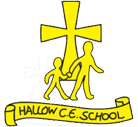Phonics at Hallow
At Hallow School, we are following Government guidance with regards to 6 phases of phonics teaching (Letters and Sounds). This six phase teaching programme focuses on high quality phonic work. The intention is to “…equip children with the phonic knowledge and skills they need to become fluent readers by the age of seven.”
We teach the children to learn each letter by its sound, not its name. For example, the letter a should be called a (as in ant) not ai (as in aim). Similarly, the letter n should be nn (as in net), not en. This will help children when learning to blend at a later stage.
The letters are not introduced in alphabetical order. The first group (s, a, t, i, p, n) has been chosen because they make more simple three-letter words than any other six letters.
The letters b and d are introduced in different groups to avoid confusion. Sounds that have more than one way of being written are initially taught in one form only. For example, the sound ai (rain) is taught first, and then alternatives a-e (gate) and ay (day) follow later.
Blending
Blending is the process of saying the individual sounds in a word and then running them together to make the word. For example, sounding out d- o- g and making dog. It is a technique every child will need to learn, and it improves with practice. To start with you should sound out the word and see if a child can hear it, giving the answer if necessary. Some children take longer than others to hear this. The sounds must be said quickly to hear the word. It is easier if the first sound is said slightly louder.
Remember that some sounds (digraphs) are represented by two letters, such as sh. Children should sound out the digraph (sh), not the individual letters ( s - h ). With practice they will be able to blend the digraph as one sound in a word. So, a word like rain should be sounded out r-ai-n, and feet as f-ee-t. This is difficult to begin with and takes practice. When sounding out a blend, encourage children to say the two sounds as one unit, so fl-a-g not f-l-a-g. This will lead to greater fluency when reading.

